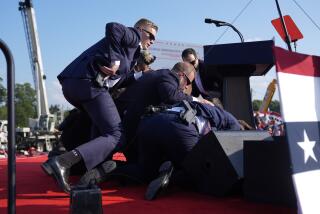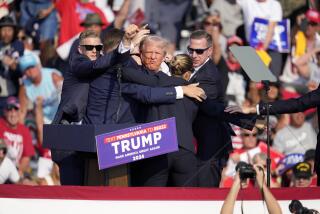A White House Moat: The Clear Symbolism : And--like it or not--there’s probably a lot more to come
- Share via
In the best of all worlds, America might have toughed it out and not changed anything after the two attacks on the White House last fall. Why let the kooks have the satisfaction of knowing you’re ruffled? But of course the bombing of the Oklahoma City federal building changed all that, perhaps even changed America forever. And not for the better.
This nation is now, inarguably, a nation of too much violence, too many explosives and too many guns; a society of too many seriously disturbed people capable of using those explosive and guns to create mayhem and destroy lives. Indeed, President Clinton on Saturday described his order to close the most famous two blocks of Pennsylvania Avenue to vehicular traffic as “a practical step to protect against the kind of attack we saw in Oklahoma City.”
Neither the September incident in which a stolen plane crash-landed on the White House’s South Lawn, nor the October scare, in which a man fired 29 rounds from a semiautomatic rifle at the White House, would have been deterred or deflected by the new cordon sanitaire in front of the presidential mansion. Clearly, the intent of setting rows of barricades and large concrete planters is to blunt the possibility of an explosive-carrying truck making a run at the White House.
Far more than its practical effect, the President’s reluctant acquiescence to measures long advocated by the Secret Service is filled with heavy symbolic freight. Unlike the presidential palaces of juntas and despotic regimes throughout the world, the White House has always been remarkably accessible, as if an index of America’s political stability. No longer. And take this development as a signal of more dramatic changes to come in the texture of American life, of further national introspection on which freedoms at the margins of our lives we might be willing to trade if the clear effect would be a greater level of security in those vital but vulnerable places, such as schools and work sites.
Impossible? Inconceivable? Consider the outcry that greeted the installation of metal detectors at the nation’s airports and the attendant long lines that ensued. No American air traveler would accept this security imposition, it was said at the time. But now it is hard to imagine anyone wanting to board an airplane that did not check its passengers for weapons.
Other kinds of minor but palpable diminishment in the devil-may-care American lifestyle are now obviously in prospect. Clearly, though all Americans will want to acknowledge the need for greater security, they will not want to relinquish the commitment to the very fundamentals of freedom that make this nation so worth defending and preserving. But to achieve the necessary delicate balance, cooperation, not confrontation, is needed. Civil liberties groups will need to work more closely with law enforcement, and vice versa, and resort to lawsuits less frequently. For instance, new measures of gun control may well require a consensual understanding about the need for some reductions of search and seizure protections.
Is America up to that kind of mature, working-together re-examination? It had better be. Clinton, perhaps the most gregarious chief executive since Lyndon Johnson, has just reduced access to the White House. This is a sad day for America. But it also should tell us that something very new is in the air. We need to face it.
More to Read
Sign up for Essential California
The most important California stories and recommendations in your inbox every morning.
You may occasionally receive promotional content from the Los Angeles Times.










